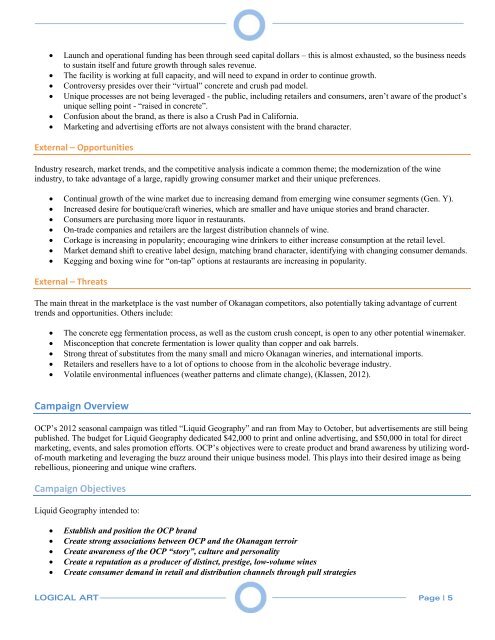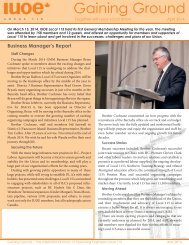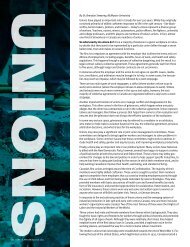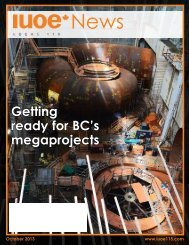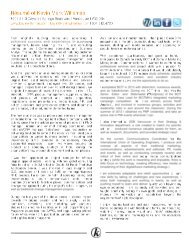OKANAGAN CRUSH PAD
Create successful ePaper yourself
Turn your PDF publications into a flip-book with our unique Google optimized e-Paper software.
Launch and operational funding has been through seed capital dollars – this is almost exhausted, so the business needs<br />
to sustain itself and future growth through sales revenue.<br />
The facility is working at full capacity, and will need to expand in order to continue growth.<br />
Controversy presides over their “virtual” concrete and crush pad model.<br />
Unique processes are not being leveraged - the public, including retailers and consumers, aren’t aware of the product’s<br />
unique selling point - “raised in concrete”.<br />
Confusion about the brand, as there is also a Crush Pad in California.<br />
Marketing and advertising efforts are not always consistent with the brand character.<br />
External – Opportunities<br />
Industry research, market trends, and the competitive analysis indicate a common theme; the modernization of the wine<br />
industry, to take advantage of a large, rapidly growing consumer market and their unique preferences.<br />
Continual growth of the wine market due to increasing demand from emerging wine consumer segments (Gen. Y).<br />
Increased desire for boutique/craft wineries, which are smaller and have unique stories and brand character.<br />
Consumers are purchasing more liquor in restaurants.<br />
On-trade companies and retailers are the largest distribution channels of wine.<br />
Corkage is increasing in popularity; encouraging wine drinkers to either increase consumption at the retail level.<br />
Market demand shift to creative label design, matching brand character, identifying with changing consumer demands.<br />
Kegging and boxing wine for “on-tap” options at restaurants are increasing in popularity.<br />
External – Threats<br />
The main threat in the marketplace is the vast number of Okanagan competitors, also potentially taking advantage of current<br />
trends and opportunities. Others include:<br />
The concrete egg fermentation process, as well as the custom crush concept, is open to any other potential winemaker.<br />
Misconception that concrete fermentation is lower quality than copper and oak barrels.<br />
Strong threat of substitutes from the many small and micro Okanagan wineries, and international imports.<br />
Retailers and resellers have to a lot of options to choose from in the alcoholic beverage industry.<br />
Volatile environmental influences (weather patterns and climate change), (Klassen, 2012).<br />
Campaign Overview<br />
OCP’s 2012 seasonal campaign was titled “Liquid Geography” and ran from May to October, but advertisements are still being<br />
published. The budget for Liquid Geography dedicated $42,000 to print and online advertising, and $50,000 in total for direct<br />
marketing, events, and sales promotion efforts. OCP’s objectives were to create product and brand awareness by utilizing wordof-mouth<br />
marketing and leveraging the buzz around their unique business model. This plays into their desired image as being<br />
rebellious, pioneering and unique wine crafters.<br />
Campaign Objectives<br />
Liquid Geography intended to:<br />
Establish and position the OCP brand<br />
Create strong associations between OCP and the Okanagan terroir<br />
Create awareness of the OCP “story”, culture and personality<br />
Create a reputation as a producer of distinct, prestige, low-volume wines<br />
Create consumer demand in retail and distribution channels through pull strategies<br />
LOGICAL ART Page | 5


